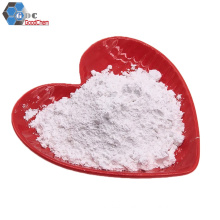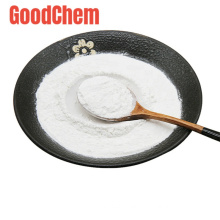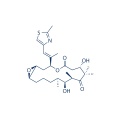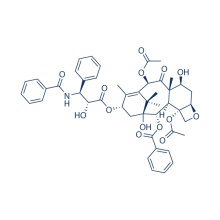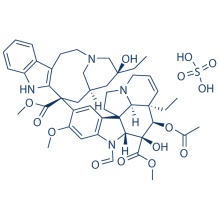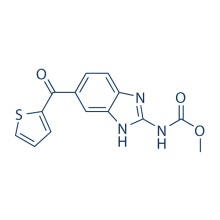.cp_wz tabla {borde superior: 1px sólido #ccc; borde izquierdo: 1px sólido #ccc; } .cp_wz table td {borde derecho: 1px sólido #ccc; borde inferior: 1px sólido #ccc; padding: 5px 0px 0px 5px;} .cp_wz table th {border-right: 1px solid #ccc; border-bottom: 1px solid #ccc; relleno: 5px 0px 0px 5px;} \ n Peso molecular: \ n 493.66 Epotilona A es un agente estabilizador de microtúbulos similar al taxol con EC0.01 de 2 μM. \ n Actividad biológica La epotilona A, descubierta en la myxobacterium Sorangium cellulosum, es un agente estabilizador de microtúbulos similar al taxol que induce la polimerización de la tubulina, lo que lleva a la detención del ciclo celular en la transición G2-M, citotoxicidad y apoptosis. La epotilona A inhibe de forma potente la proliferación celular en las células HCT116, con una CI50 de 4,4 nM. La epotilona A también muestra citotoxicidad en las células KB3-1, KBV-1, Hela y Hs578T, con valores de CI50 que oscilan entre 13 nM y 160 nM. La epotilona A es más soluble en agua que el Taxol y compite con el Taxol en la unión con los microtúbulos, con una CI50 de 2,3 µM. Sin embargo, tanto la epotilona A como el taxol no comparten un farmacóforo común y explotan el bolsillo de unión a la tubulina de forma única e independiente. Recientemente, se ha encontrado que la transformación microbiológica de Epotilona A por Aspergillus niger AS 3.739 produce varios metabolitos que también son tóxicos para las células MCF-7, pero con valores de CI50 mucho más altos. Protocolo (solo como referencia) Ensayo de quinasa: [1]
|
Tubulin polymerization assay
|
Calf brain microtubule proteins (MTP) are purified, which includes approximately 15%–20% microtubule associated proteins. The buffer (MES buffer) used for the Epothilone A-microtubule studies contains 0.1 M 2-morpholinoethanesulfonic acid (MES), 1 mM EGTA, 0.5 mM MgCl2, and 3 M glycerol at pH 6.6. Samples for electron microscopy are placed on carbon-over-Parlodion-coated grids (300 mesh) and negatively stained with 2% uranyl acetate. Microtubule assembly in the presence or absence of Epothilone A is monitored spectrophotometrically by using a spectrophotometer equipped with a thermostatically regulated liquid circulator. The temperature is held at 35 °C and changes in turbidity (representative of polymer mass) are monitored at 350 nm. Effective concentration (EC0.01), defined as the interpolated concentration capable of inducing an initial slope of 0.01 OD/min rate, is calculated using the formula EC0.01 = concentration/slope and expressed as the mean with standard deviation obtained from three different concentrations.
|
Ensayo celular: [2]
|
Cell lines
|
KB3-1, KBV-1, Hela, and Hs578T cells
|
|
Concentrations
|
0–2 μM
|
|
Incubation Time
|
24 hours for mitotic arrest or 72 hours for cytotoxicity
|
|
Method
|
For mitotic block and aberrant mitosis, cells are plated either in 48-well plates (for trypan blue and cell counting) or onto coverslips. After 24 hours, cells are treated with Epothilone A and are scored at regular intervals. For the cytotoxicity analysis, cells are counted and scored as trypan blue positive or negative. Concurrently, coverslips and aliquots of cells in the culture supernatant are fixed and stained with Hoechst 33342 in PBS. These cells are scored for cells blocked at the G2-M transition and aberrant mitosis.
|
Conversión de diferentes modelos de animales basados en BSA (valor basado en datos del Borrador de Directrices de la FDA)
|
Species
|
Baboon
|
Dog
|
Monkey
|
Rabbit
|
Guinea pig
|
Rat
|
Hamster
|
Mouse
|
|
Weight (kg)
|
12
|
10
|
3
|
1.8
|
0.4
|
0.15
|
0.08
|
0.02
|
|
Body Surface Area (m2)
|
0.6
|
0.5
|
0.24
|
0.15
|
0.05
|
0.025
|
0.02
|
0.007
|
|
Km factor
|
20
|
20
|
12
|
12
|
8
|
6
|
5
|
3
|
|
Animal A (mg/kg) = Animal B (mg/kg) multiplied by
|
Animal B Km
|
|
Animal A Km
|
Por ejemplo, para modificar la dosis de resveratrol utilizada para un ratón (22,4 mg / kg) a una dosis basada en el BSA para una rata, multiplique 22,4 mg / kg por el factor Km para un ratón y luego divida por el factor Km para una rata. Este cálculo da como resultado una dosis equivalente para ratas de resveratrol de 11,2 mg / kg.
|
Rat dose (mg/kg) = mouse dose (22.4 mg/kg) ×
|
mouse Km(3)
|
= 11.2 mg/kg
|
|
rat Km(6)
|
Información química
|
Molecular Weight (MW)
|
493.66
|
|
Formula
|
C26H39NO6S
|
|
CAS No.
|
152044-53-6
|
|
Storage
|
3 years -20℃Powder
|
|
6 months-80℃in solvent (DMSO, water, etc.)
|
|
Synonyms
|
|
|
Solubility (25°C) *
|
In vitro
|
DMSO
|
99 mg/mL
(200.54 mM)
|
|
Water
|
<1 mg/mL
(
|
|
Ethanol
|
99 mg/mL
(200.54 mM)
|
* <1 mg/ml means slightly soluble or insoluble.
* Please note that Selleck tests the solubility of all compounds in-house, and the actual solubility may differ slightly from published values. This is normal and is due to slight batch-to-batch variations.
|
|
Chemical Name
|
(1S,3S,7S,10R,11S,12S,16R,E)-7,11-dihydroxy-8,8,10,12-tetramethyl-3-(1-(2-methylthiazol-4-yl)prop-1-en-2-yl)-4,17-dioxa-bicyclo[14.1.0]heptadecane-5,9-dione
|
Calculadora de molaridad Calculadora de dilución Calculadora de peso molecular
Grupos de Producto : Señalización citoesquelética > Inhibidor asociado a microtúbulos
